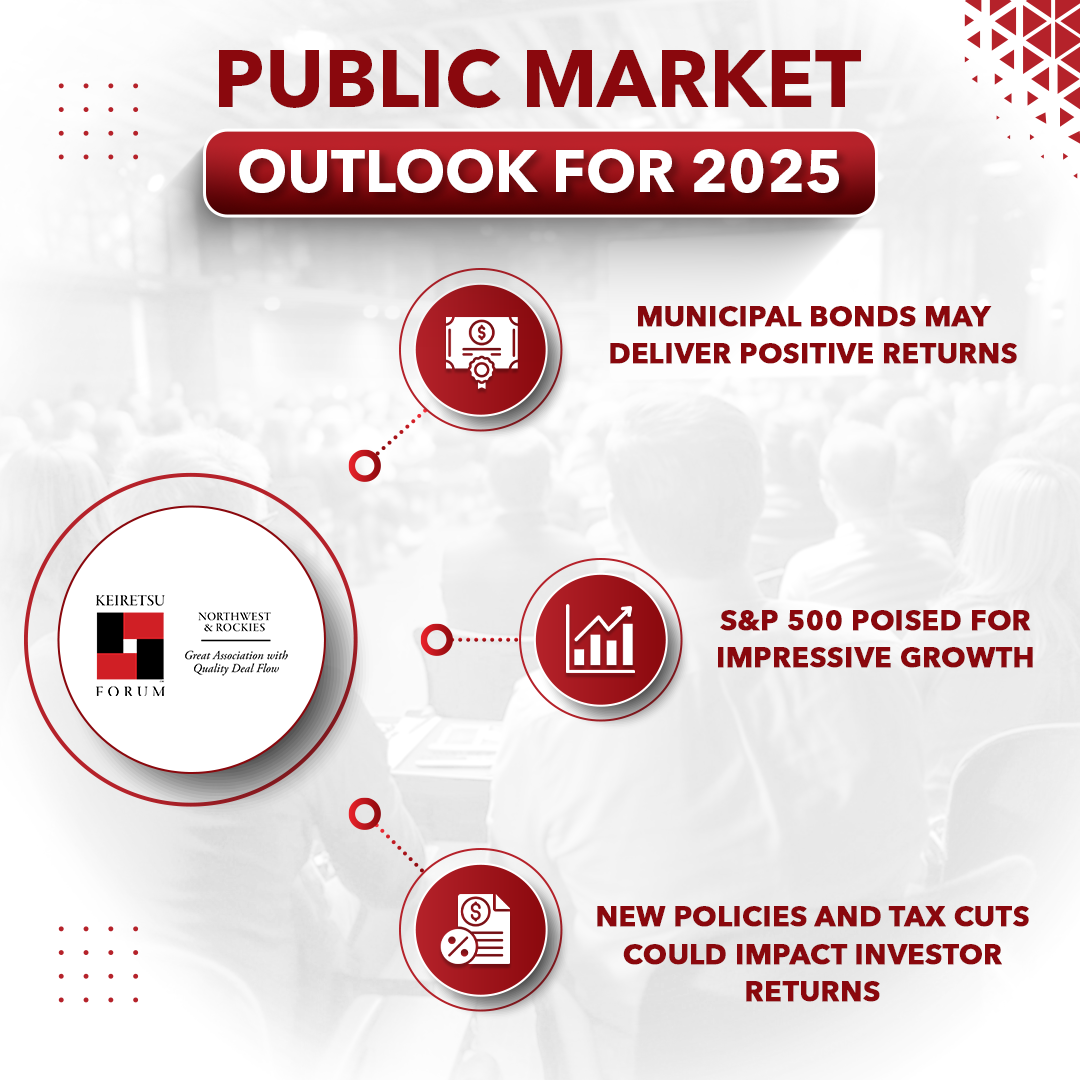
2024 has been a strong year for public markets, and as the year winds down, there’s a lot to unpack and even more to anticipate. Several asset classes were in the green, with positive signals for a much better time. Let’s dive into the highlights, break down what’s happening in markets today, and discuss the opportunities that 2025 may bring.
Equities and Bonds Are Shining Bright
Equities globally are up over 20%, with the United States leading the charge. Municipal bonds have also performed well, delivering returns of about 3%, with taxable bonds slightly edging higher. True to their nature, bonds have provided downside protection amid increasing market volatility. This balanced performance underscores their role in a diversified portfolio.
Goldman Sachs expects global and US economies to grow by approximately 2.5% by 2024’s end. The Federal Reserve implemented its first rate cut of 50 basis points in September, setting the tone for market tailwinds. Yields have shown some volatility, especially post-election, but Sean Sullivan (Investment Strategist at AllianceBernstein) expects them to settle around 4.15% by year-end.
Interest Rates: Series of Cuts or Bold Moves?
Inflation has made notable progress toward the Fed’s 2% target, a trend that has provided markets with much-needed stability. While there may still be inflationary challenges ahead, the overall trajectory is promising. Looking ahead, GDP growth in 2025 is projected to remain positive, with the US at 1.5% and global growth at 2.5%. The Feds may consider additional cuts, which could drive the 10-year treasury yield to around 3.75% by year-end 2025 (as per Bernstein analysis).
Post-pandemic, the Fed raised rates aggressively (over 500 basis points in less than a year) to combat elevated inflation. Now, the question isn’t about what happened but where we go from here. If growth accelerates and inflation proves sticky, the Fed may maintain higher rates for longer. Conversely, if economic growth slows significantly, leading to job market weakness, the Fed could cut rates more aggressively to stave off a recession.
Lower interest rates make venture capital and angel investments more attractive than traditional fixed-income investments. As yields on safer assets like Treasury bills decrease, investors may be more willing to take on higher risks for potentially more significant returns. Additionally, lower interest rates often result in more dry powder available for startups and early-stage companies.
However, angel investors should also be aware of potential risks in 2025:
Inflation uncertainty: If inflation remains above the Fed's 2% target, it could lead to higher interest rates, potentially squeezing corporate profits and dampening market sentiment.
Geopolitical tensions: Ongoing global conflicts and trade disputes could impact startup performance and investor confidence.
Market volatility: Changes in interest rate expectations may lead to fluctuations in public market valuations, which could affect private market dynamics.
The Rise of Secondaries
Secondary players have had an exceptionally active 2024. Deal volume exceeded $70 billion in the first half of 2024, positioning the market to surpass $140 billion by year-end. Secondary capital has been in high demand throughout the year as LPs (Limited Partners) and GPs (General Partners) sought liquidity in an exit-constrained environment. LPs' primary motivation has been to unlock capital for funding existing commitments and making new fund investments. Meanwhile, GPs have faced pressure to provide liquidity to their LPs and have increasingly turned to the secondary market to achieve this without selling prized assets in a stagnant M&A market.
Opportunities for 2025
2024 is building positive momentum for investors, and here’s what to expect from 2025:
Cash and Bonds: Time for Calculated Steps
For investors holding cash, now is the time to reconsider. Over $6.5 trillion is sitting in money markets, earning a decent yield of 4.5-5%. If the Fed decides to cut rates, the taxable nature of the yields could erode net returns. So what to do?
Sean suggests extending the duration into the bond market. Municipal bonds offer an attractive opportunity. If yields drop by 80 basis points, Sean predicts the returns could reach 7% tax-free. So, even in less favorable scenarios, bonds can offer positive returns.
High Earnings on the Cards
2023 was a stellar year for equities, with the S&P 500 up 20%. However, that growth was mainly driven by multiple expansions rather than earnings, which declined by nearly 3%. In 2024, higher valuations were supported by an expected 8% earnings growth. For 2025, the Bernstein analysis points towards a robust 10% earnings growth, suggesting further price appreciation, even with valuations where they stand today.
For the S&P 500, Sean forecasts mid-to-high single-digit price returns, with an additional 2% dividend yield bringing total returns to the high single digits. But let’s consider two extremes based on the Bernstein analysis:
Bull Case: If the US economy accelerates, earnings could grow by 13%, supported by policy tailwinds like corporate tax cuts.
Bear Case: Persistent inflation or geopolitical shocks could lead to slower earnings growth (<5%) and tighter monetary policy, resulting in weaker equity performance. However, this scenario carries only a 15% probability.
The Election Factor
As anticipated, the recent election outcomes have driven equities, yields, and the dollar higher. Republican-led policies, including extended tax cuts and fiscal expansion, have boosted markets. Tariff policies may also come into play, though the timing and scope remain uncertain. There’s no need for drastic portfolio changes for now, but staying agile will be key as new policies approach implementation.
Strategies for the Road Ahead
1. Buffered Equity Strategies
Sean advocates for buffered equity strategies heading into 2025 to navigate market uncertainties. For instance, owning the S&P 500 with a 15% downside buffer can help mitigate risk, even if gains are limited to 8-12%.
2. Private Markets: Credit, Equity, and Venture
By the end of Q3 2024, private equity deals saw a 36% increase in value and an 18% rise in volume compared to the same period in 2023. Fundraising in the US matched last year’s levels, signaling strong investor interest. However, exits remain the missing piece of the recovery puzzle, with little change this year. By Q3 2024, the global value realized from private equity portfolios stood at $635 billion, compared to $745 billion for the entire year of 2023. Core private credit remains a strong asset class, holding significant promise for outsized returns in a more favorable economic climate.
Public markets performed very well in 2024, and the coming year presents a landscape of steady growth, easing monetary policy, and opportunities across asset classes. However, it would be wise to stay proactive and well-informed before making any move.
References:
Sean Sullivan’s keynote Public Markets Outlook 2025
https://www.goingvc.com/post/how-rising-interest-rates-impact-venture-capital-2
https://www.inc.com/richard-feloni/why-venture-capital-is-poised-for-a-rebound-in-2025/91065601
https://www.moonfare.com/blog/private-equity-outlook-2025
https://www.goldmansachs.com/pdfs/insights/briefings/ASolidGrowthOutlookFor2025.pdf
https://www.inc.com/richard-feloni/why-venture-capital-is-poised-for-a-rebound-in-2025/91065601


